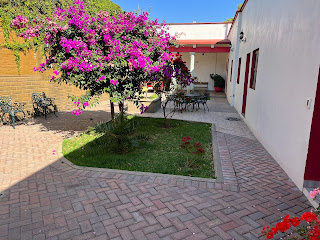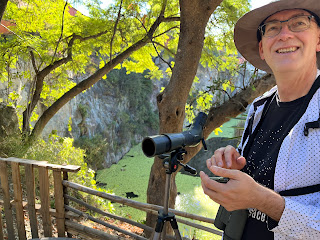There are a lot of people who don’t have cars of their own in Mexico, who still need to get to and from work, or school, or to the next town over for a doctor’s appointment or to transport a bag of carrots to market, or to visit family….all of the reasons that people need to travel.
That means that there are lots of different ways to get around, at various levels of price and convenience.
Within a town:
• In smaller towns, or in some suburbs of larger cities, tuktuks are common. A tuktuk is otherwise known as a moto-taxi: a motorcycle appended to a 2-3 person cabin. Tuktuks often help folks up hills, and rarely travel further than about 2 km. Fares range from 10 pesos to 50 pesos, depending on the distance and the remoteness of the destination. (If the driver is unlikely to get a passenger on the way back, you may pay more).
Photo stolen from the "Mototaxis for sale" Facebook page because I wasn't clever enough to take my own picture.
Within a city:
• Public buses, running on fixed routes, just like in Canada. Price: In Oaxaca, 8 pesos/person. (~0.60 )
• Private taxi: variable cost, depending both on the distance travelled and the specific taxi driver. In Oaxaca, the cost of a ride within the city that would take 20-30 minutes to walk averaged 60 pesos ($4), but could be anywhere from 45 pesos to 70 pesos ($3-$4.70). The standard rate for ride from the centro to the ruins at Monte Alban was 200 pesos ($13) when we arrived in November, and had risen to 250 pesos ($17) a few weeks later.
Between cities in the central valley of Oaxaca and to major centres in the Sierra Norte:
• Intercity bus: Some popular routes have frequent scheduled bus service. For example, a second class bus (like a Greyhound) runs between Oaxaca and Mitla every half hour or so, and costs about the same as a collectivo. (40 pesos or $2.70)
• Bus: These buses are something between a city bus and an intercity bus in comfort. They run on a fixed route, but not necessarily to a fixed schedule. They seem to shuttle back and forth. Cost per person is fixed, irrespective of how far you ride. For example, Oaxaca to Tlacalula (1 hour away) was 22 pesos/person
• Collectivos: shared taxis that run on a set route, but not at a set time. For shorter routes the collectivos basically shuttle back and forth, leaving whenever they are fullish, and stopping to pick up additional passengers if there’s room. For longer routes, they leave from a fixed point and leave only when full. Cost: Oaxaca to Mitla (1.5 hours away): 40 pesos per person.
• Taxi: You can engage a private taxi. Apparently the going rate is 200 pesos an hour, although I suspect that tourists pay up to twice as much.
Between cities that are further apart:
• 1st class buses: air conditioned, cushioned seats, washrooms, and “in flight” entertainment. On the Super First Class buses, they don’t even blare the audio into the bus at large: you can listen on headphones if you’re interested! They run on a fixed schedule. Depending on the route and the distance, they may run anywhere from once a day to once an hour. Seats are reserved, and you can only board at a station.
• 2nd class buses: more run-down versions of the 1st class buses, may not have air conditioning. We didn’t end up taking any second class buses so I’m not sure of the details.
• Vans: The most economical and fastest way to travel between Oaxaca City and the coast is by 10-15 seat multi-passenger van. Depending on the route and the operator, they run somewhere between every ½ hour and every 2 hours. They leave from a fixed station, and stop at fixed points in major centers in-between. You can also flag them down by the side of the road.
• Collectivos: shared taxis, that are generally only available between towns that are up to about 2 hours apart. Fare is fixed, depending on the destination, but tends to be 40 or 50 pesos per person.
• Taxi: You can negotiate a private taxi ride between cities. Cost is whatever the market will bear.
• Camioneta: Haven’t taken these, but we’ve seen them on the roads. Seem to run only in rural areas. Basically, they’re a pickup truck. Most commonly the pickup has standing room in the back (with a metal cage around the box that you hang on to as the truck moves), but may instead have a tarp covering and bench seats in the back, or cargo space in the box and seating in a king cab in front.
Camioneta with cargo in back and a king cab for passengers
All of this means that if you’re a bit brave, you can head to a random destination with reasonable certainty that you’ll be able to get there and get back again with reasonable efficiency.
For example, we visited the ruins of Yagul using a combination of bus, private taxi, and collectivo.
• We started by taking a private taxi to the place where collectivos leave for Mitla (the town about 20 minutes past our destination). Cost: 70 pesos
• We stood around waiting for a Mitla collectivo for about 15 minutes. When one didn’t show up, we decided to take a bus to Tlacolula, which is a few km short of our destination. Cost: 22 pesos each.
• We waved down a taxi in Tlacolula. The driver asked for the outrageous sum of 100 pesos ($7) for the 4 km drive because we were gringos going to a tourist site. We sighed and paid instead of getting out of the cab in a huff.
• We spent a few hours visiting the ruins and birding, walking the 1.5 km back to the highway.
• Oops! We tried waving down a collectivo, but every one that passed us was full. About 10 of them in a row! Are we going to have to walk the 2.5 km back to Tlacolula along a busy highway with no shoulder??? Whew! Here’s one with two seats empty! We can get a ride all the way back to Oaxaca city after all. Total wait time: 7 minutes. Cost: 40 pesos each.
Total cost of transportation for the day: 294 pesos, or $19.60. Total planning: zero. Total travel time: 2.5 hours. Total time waiting for transportation: 23 minutes (would have been about 10 minutes less if we’d taken the earlier bus to Tlacolula instead of continuing to wait for a collectivo Mitla on our way out).
Second example: travelling from San Jose del Pacifico to Pluma Hidalgo.
Google maps stubbornly refuses to acknowledge the existence of the town of San Jose del Pacifico, but Cabanas La Cumbre are situated there.
These are two towns in the mountains between Oaxaca City and the Pacific Coast, about 2.5 hours apart, in a region that is far less populated than the central valleys of Oaxaca. There are regularly scheduled vans between San Jose and Pochutla, a large town on the more major of the two routes to the coast (the 175). We were led to believe that there was an hourly van to Pluma Hidalgo too, but when we asked in San Jose we were greeted with something between incomprehension and a wince. As in “You want to go to Pluma Hidalgo from here?”
The driver of one of the vans headed to Pochutla suggested that we ride with him as far as La Copalita, at the crossroads where the road to Pluma Hidalgo branches off. “Is there transportation from La Copalita to Pluma?” answer <shrug> “it’s easier when you’re closer”. Okay, challenge accepted. We travel 1.5 hours down the windiest highway I’ve ever been on in my life to a cross roads in the middle of nowhere. The van drops us off with our luggage.
Hopeful sign: there are other people waiting. Unhopeful sign: when we say we’re headed to Pluma Hidalgo, they answer “you just missed it!” Ooops. Seeing our faces fall, one fellow says “it will be about 20 minutes [to the next one]”. He directs us to a bus shelter across the way, where we wait. And wait. For about 40 minutes.
Waiting for a ride to Pluma (or Godot?)
Various camionetas headed towards nearby destinations stop and pick up passengers and cargo. No cabs or collectivos of any description pass. On the bright side, 3 vans headed to Oaxaca and 1 van to Pochutla pass on the main highway, so if worst comes to worst we can probably abort and get somewhere tonight! Finally, a decrepit car pulls up and some passengers get out. “This is it” says our helpful friend, who’s still waiting for his ride.
That car in the shadows is our ride away from the crossroads.
We get in the unmarked car/informal taxi, and head towards Pluma Hidalgo. Cost: 200 pesos ($14) Again, a total ripoff by local standards, but a) we’re tourists and b) we don’t seem to have a lot of options. Thirty minutes or so later, we arrive at our destination. Safely, despite the driver. And despite the shakedown when we arrive: “no, it’s 300 pesos!” “But you said 200 pesos.” “but you didn’t go to the hotel I suggested.” <Harvey glowers> “Okay, 250 pesos”. Grimace, and pay, because it's $3.50 and we just want to be rid of him.




















































